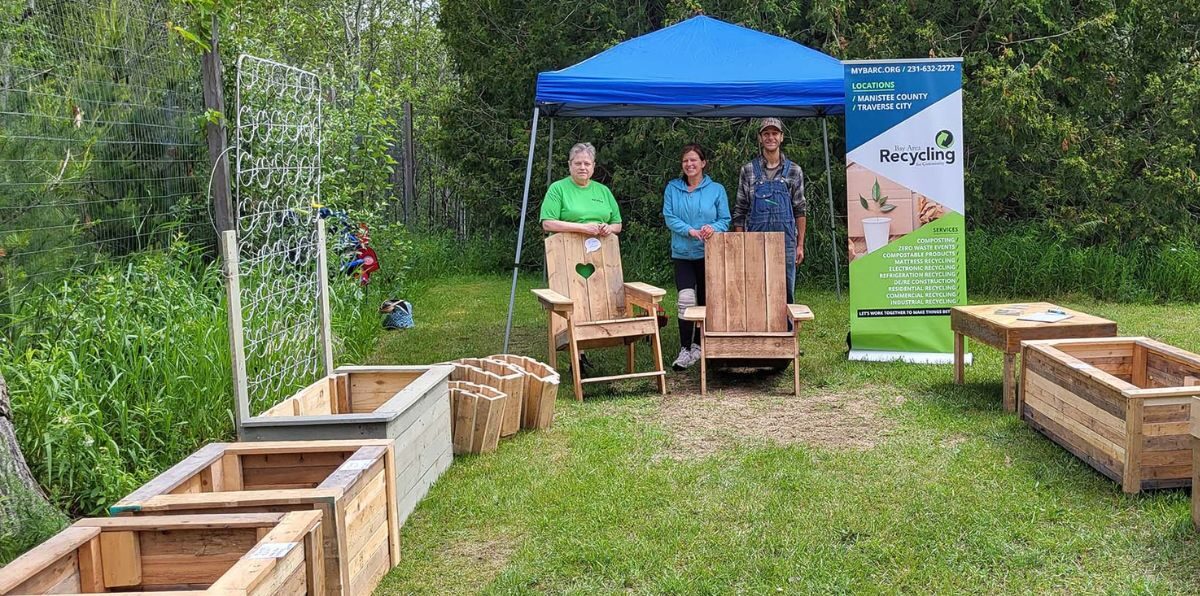Recycling vs. Upcycling: What’s the Difference?
Most of us know the drill with recycling—sort the bottles, cans, and paper into the blue bin and feel good about doing our part. But upcycling? That’s a whole different ball game of getting creative with waste reduction. Think of it as recycling with a creative twist, turning old items into something entirely new without breaking them down. If recycling is the practical one in the family, upcycling is the artsy older sibling who can turn a broken dresser into a chic home coffee bar with just a little paint and vision.
At Bay Area Recycling for Community, we’re big fans of both recycling and upcycling, and we incorporate both into our sustainability practices daily. Let’s explore the unique benefits of each, look at some inspiring upcycling projects, and dive into how we use upcycling within our core initiatives to create a greener community here in Northern Michigan!
Understanding the Difference: Recycling vs. Upcycling
Recycling is the process of collecting and processing materials to create new products to continue the use cycle. Common recyclables include paper, plastic, glass, and metal, which are broken down into raw materials and then reformed into new products. This process saves energy, reduces greenhouse gas emissions, and lessens the need for raw materials.
For example, at BARC, we recycle mattresses by repurposing each component for various uses! Memory foam is reused for carpet padding or dog beds; the quilted top layer is made into absorbent products; tempered steel springs are melted down for new metal products. The box spring’s wooden frame is broken down into wood chips for fuel or mulch, and shoddy pads, often made of cotton, are reused in textiles.
Upcycling involves taking old or discarded items and creatively transforming them into something new, often with a different purpose. Unlike recycling, which breaks materials down, upcycling preserves much of the original item’s integrity, reducing energy use and giving objects a second life while cutting down on demand for new products.
For example, at BARC, we upcycle through our De/Re Construction initiative, where we combine materials from various pieces to craft unique furniture and structures. Stop by our Kaleva Resale Shop where the showcases display shelves and cases made from upcycled materials. We also take the wood from De/Re to create repurposed products for sale like picnic tables, large wooden or steel flower boxes, garden trellises, chicken coops, and greenhouses.
Environmental Benefits of Recycling and Upcycling
Both recycling and upcycling play essential roles in sustainable waste management. Recycling can keep tons of materials out of landfills, helping to decrease the pollution associated with waste breakdown. By processing recyclable materials, we reduce the need to extract, refine, and process new resources, ultimately saving energy and cutting emissions. Upcycling also promotes environmental health by transforming waste into valuable items. By breathing new life into existing materials, upcycling helps conserve energy by skipping the intensive processes needed for recycling. It’s a sustainable choice that brings creativity to sustainability, making it perfect for DIY projects and reducing demand for mass-produced items.
DIY Upcycling Projects to Try at Home
Furniture Makeovers
Instead of buying new, give outdated furniture a new look with paint, fabric, or wood refinishing. An old dresser can be transformed into a stylish sideboard, or a wooden pallet can become a unique coffee table. Refinishing techniques like distressing or adding new hardware can add a modern twist to vintage pieces!
Repurposing Old Clothes
If you like to sew and get crafty, you can turn old clothes into new items! Old jeans can become durable tote bags, t-shirts can be transformed into braided rugs or pillows, and wool sweaters make perfect cozy mittens or hats. Upcycled clothing projects can bring a fresh look to your wardrobe or your home.
Everyday Item Transformations
Mason jars, wine bottles, and tin cans are perfect materials for upcycling. Mason jars make charming candle holders or plant pots, while wine bottles can be turned into decorative vases or even lamps with a little drilling and wiring. Tin cans make great pencil holders, planters, or utensil organizers with a little paint and creativity.
How BARC Incorporates Upcycling into Our Sustainability Strategy
At BARC, upcycling is an essential component of our sustainability efforts. Through our de/reconstruction projects, we aim to salvage as much material as possible, ensuring that materials like wood, metal, and fixtures are given new life. These materials are often upcycled into furniture, decor, or construction elements, keeping valuable resources out of landfills while supporting sustainable building practices. Our upcycling initiatives are part of our zero-waste mission to help create a circular economy where resources are reused, repurposed, and cherished.
Both recycling and upcycling are powerful ways to help reduce waste, conserve resources, and create a cleaner environment. Whether it’s sorting recyclables at home or turning an old chair into a stunning piece of decor, each effort counts. Join us at BARC in making sustainable choices that reduce waste and elevate creativity, one recycled and upcycled piece at a time!
